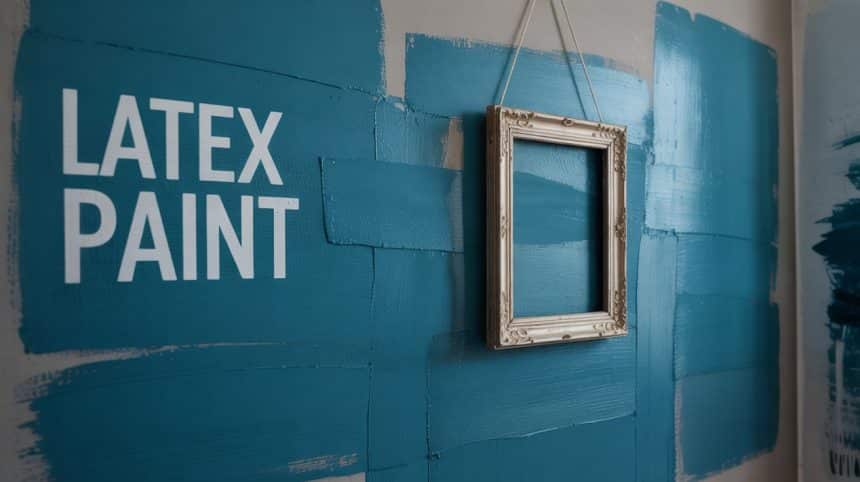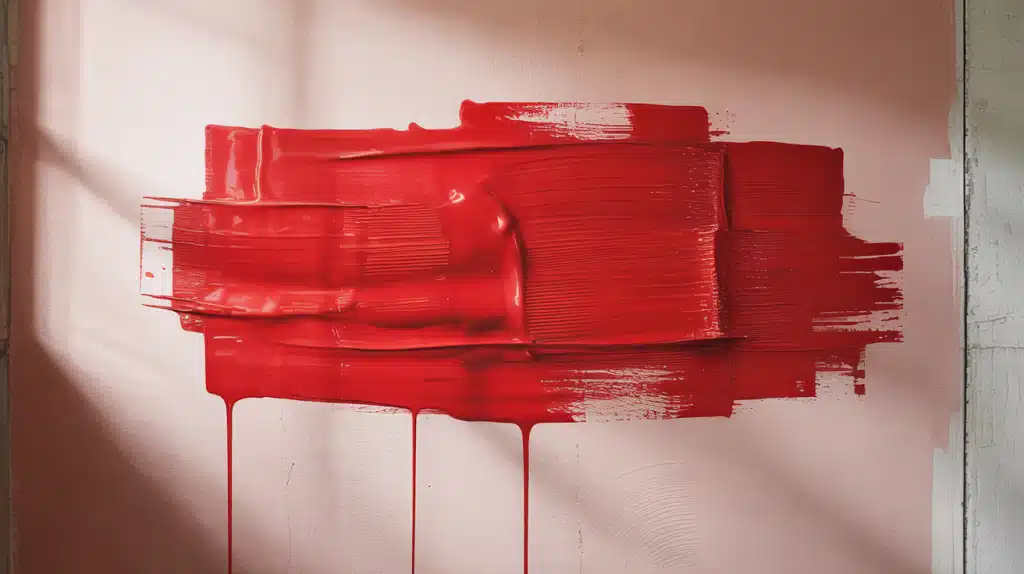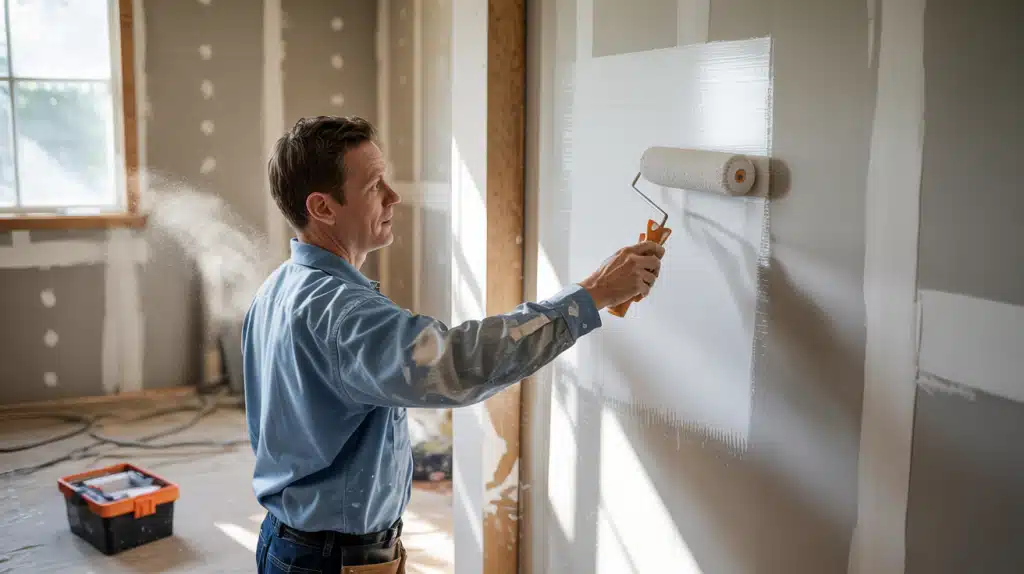Ever stood in a paint aisle feeling completely overwhelmed? You’re not alone. Among the countless options, latex paint stands out as a popular choice, but what exactly is it?
Unlike its name suggests, it has nothing to do with rubber gloves or balloons. The secret behind latex paint is much more fascinating.
From your living room walls to your kitchen cabinets, this versatile paint might already be part of your home without you realizing it. Its unique properties have made it a go-to for both DIY enthusiasts and professional painters alike.
But what makes latex paint special? And is it really the right choice for your next project?
Let’s pull back the curtain on this household staple and discover why it might be the unsung hero of your home renovation dreams.
What Is Latex Paint?
Latex paint is a water-based paint made with synthetic polymers, such as acrylic or polyvinyl acetate. Despite the name, it doesn’t contain natural latex from rubber trees. The term “latex” actually refers to the paint’s consistency and appearance, which resembles the milky substance found in some plants. Modern formulations have undergone significant improvements since their introduction in the 1940s, offering impressive coverage and durability that rival oil-based alternatives.
- Water-based formula with synthetic polymers like acrylic or polyvinyl acetate
- Contains no natural rubber latex despite its misleading name
- Fast-drying properties allow multiple coats in a single day
- Flexible and durable coating that resists cracking during temperature changes
- Low in harmful fumes (low VOCs), making it safer for indoor use
- Simple cleanup with soap and water – no harsh chemicals needed
- Advanced features in premium versions include stain-blocking and mildew resistance
- Color retention remains excellent over time without yellowing
This versatility has made latex paint the go-to choice for both DIY enthusiasts and professional painters. Whether you’re refreshing a bedroom, updating kitchen cabinets, or protecting exterior siding, latex paint offers a practical solution that strikes a balance between performance and convenience. Its widespread availability in virtually any color imaginable means you’ll never have to compromise between the perfect shade and the right paint formula for your project.
How Is Latex Paint Made?
Latex paint combines a few simple ingredients to create that perfect can of color for your walls. Water serves as the main carrier, replacing the harsh oils or turpentine found in other paints. Mixed with carefully selected pigments for color and synthetic binders, such as acrylic polymers, for durability, the paint forms a strong yet flexible coating that adheres well to surfaces.
- Water is the primary carrier (not oils or turpentines)
- Pigments provide the specific color you choose
- Binders (acrylic polymers) ensure adhesion and longevity
- Available in multiple finishes: flat, eggshell, satin, semi-gloss, and high-gloss
Choosing the Right Paint: Latex vs Oil-Based vs Acrylic
Navigating the paint aisle can feel like decoding a foreign language. With so many options available, understanding the differences between latex, oil-based, and acrylic paints can help you make the best choice for your specific project. Each type has unique properties that make it suitable for different applications.
| Feature | Latex Paint | Oil-Based Paint | Acrylic Paint |
|---|---|---|---|
| Base | Water | Oil (linseed, alkyd) | Water |
| Drying Time | Fast (30-60 min touch-dry) | Slow (6-8 hours) | Medium-Fast (20-30 min) |
| VOC Levels | Low | High | Low to Medium |
| Best For | Drywall, plaster, concrete | Wood, trim, high-traffic areas | Detailed work, crafts, furniture |
| Flexibility | High (resists cracking) | Low (hard and brittle) | Very High (extremely flexible) |
| Color Vibrancy | Good | Excellent depth | Vibrant, maintains intensity |
| Color Stability | Excellent (no yellowing) | Tends to yellow over time | Excellent (UV resistant) |
| Clean Up | Easy (soap and water) | Requires chemicals (turpentine) | Easy (soap and water) |
| Cost | Moderate | High | Higher than latex |
| Durability | Good | Excellent | Excellent |
Your project’s specific needs should guide your paint selection. For everyday wall painting and large interior surfaces, latex paint offers convenience and good results.
When working on woodwork, trim, or areas that need exceptional durability, oil-based paint might be worth the extra effort. For artistic projects, furniture makeovers, or areas requiring exceptional flexibility and vibrant colors, acrylic paint delivers superior performance.
Where Can You Use Latex Paint?
Latex paint is incredibly versatile, making it suitable for a wide range of surfaces throughout your home. You don’t need to be a painting expert to get great results with this user-friendly option.
- Interior surfaces: Perfect for walls, ceilings, drywall, plaster, and wood—virtually any indoor surface can be transformed with latex paint
- Exterior surfaces: Holds up well on concrete, stucco, and siding, providing protection against weather while maintaining color integrity
- Rooms: Ideal for kitchens, bedrooms, living rooms, and hallways—each room benefits from latex paint’s low odor and quick drying time
- Furniture: Breathe new life into old furniture pieces with latex paint’s smooth application and durable finish
- Trim and molding: Latex paint with a semi-gloss or high-gloss finish works beautifully on trim, creating visual interest and washable surfaces
- Basements: The low-VOC formula makes latex paint safer for areas with limited ventilation
Its quick-drying nature and low odor make it perfect for indoor use where ventilation might be limited. On the exterior, latex paint stands up well to the elements, with flexibility that helps it withstand temperature changes without cracking or peeling. The washable versions are especially handy in high-traffic areas where walls might need occasional cleaning.
Why Latex Paint Is a Favorite Among DIYers and Pros?
There’s a reason both weekend warriors and professional painters reach for latex paint time and time again. The appeal goes beyond just its technical benefits.
Latex paint offers a beginner-friendly application that allows even first-time painters to achieve smooth, professional-looking results without specialized skills or equipment.
One of the most appreciated features is the quick project completion time. The fast-drying formula means you can finish a room in a single day—perfect for busy homeowners who can’t wait days between coats. Plus, the low odor prevents the splitting headaches that often come with painting projects, eliminating the need to evacuate your home while working.
For environmentally conscious painters, latex paint represents an earth-friendly option with its lower VOCs, making it a healthier choice for your family and the planet. At the end of a long painting day, the simple cleanup with just soap and water (no harsh chemicals required) is perhaps the most welcome feature of all.
For many DIYers, that first successful latex paint project becomes a gateway to more ambitious home improvements. The confidence that comes from transforming a space with your own hands is truly empowering—and latex paint makes that transformation accessible to everyone.
Final Thoughts
After exploring the world of latex paint, the verdict is clear- it’s a winner for most home projects. From its hassle-free cleanup to its quick-drying formula, latex paint simplifies the painting process without sacrificing quality.
Whether you’re refreshing your bedroom walls or updating exterior siding, latex paint delivers reliable results that stand the test of time. Its versatility, affordability, and low environmental impact make it hard to beat.
If you’re looking for a paint that’s easy to use, dries fast, and is kind to both your wallet and your lungs—latex paint is your new best friend.
So grab that roller, pick your perfect shade, and transform your space with confidence. Your walls (and your weekend schedule) will thank you.
Frequently Asked Questions
What is the Difference Between Latex Paint and Regular Paint?
Latex paint is water-based with synthetic polymers, while “regular paint” typically refers to oil-based paint. Latex dries faster, has lower odor, and cleans up with water.
What Are Examples of Latex Paint?
Common latex paint brands include Behr Premium Plus, Sherwin-Williams SuperPaint, Benjamin Moore Regal Select, and Valspar Signature. These come in flat, eggshell, satin, and glossy finishes.
When Should You Not Use Latex Paint?
Avoid latex paint on raw wood without primer, oil-painted surfaces without preparation, in extremely cold temperatures, or on specialty surfaces like certain metals.




